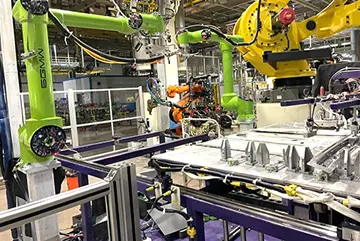1、 Application Introduction
With the gradual expansion of the development momentum of new energy vehicles, the demand for automotive power batteries is also increasing, and the automation of related battery material production has become an important part. EP3E-PN currently supports a wide range of messages, such as 1/3/5/102/105 main messages and 750/860 auxiliary messages, which can meet the overall process requirements of the production line, including positioning control, speed control, winding and unwinding control, etc; And it supports RT and IRT modes, which can accurately respond to and control the technical requirements of each link.
2、 Process requirements
Positioning control, speed control, and roll up and roll up control applications
Real time precise control of speed and winding torque
3、 System solution
1500PLC series with 27 servo drives
The servo power includes 0.1kW~15kW
4、 Advantages of the plan
The entire production line adopts distributed electrical cabinets, including 8 electrical cabinets, 27 servos, and a network cable connected in series with each electrical cabinet. Bus servo, less wiring, network cable series distributed electrical cabinet, shortening the power line and encoder of the motor
Rich message support, with 105 messages on the process axis enabling IRT mode for faster and more accurate positioning, and 1+750 messages supporting speed mode roll up and roll up, perfectly adapting to various axis process function applications
24-hour continuous operation
5、 Equipment Description EP3E-PN
Voltage level: AC 220V/380V
Power range: 0.1kW~7.5kW
Communication interface: PROFINET
Control mode: Supports messages 1, 3, 5, 102, 105, integrated positioning function, supports Siemens message 111, compatible with SINA_POS (FB284 function block), supports auxiliary messages 750, 860, etc., supports 23 bit multi turn absolute value encoder
Supports both RT and IRT real-time communication modes

In application, the automotive body process requires the use of special fixtures to apply NVH anti noise adhesive on the body sheet metal parts after they are formed and before painting, and to cooperate with robots in the handling and welding processes to for
Learn More
1、 Application Introduction With the gradual expansion of the development momentum of new energy vehicles, the demand for automotive power batteries is also increasing, and the automation of related battery material production has become an important part. EP
Learn More